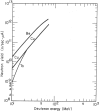Laser-plasmas in the relativistic-transparency regime: Science and applications
- PMID: 28652684
- PMCID: PMC5449275
- DOI: 10.1063/1.4983991
Laser-plasmas in the relativistic-transparency regime: Science and applications
Abstract
Laser-plasma interactions in the novel regime of relativistically induced transparency (RIT) have been harnessed to generate intense ion beams efficiently with average energies exceeding 10 MeV/nucleon (>100 MeV for protons) at "table-top" scales in experiments at the LANL Trident Laser. By further optimization of the laser and target, the RIT regime has been extended into a self-organized plasma mode. This mode yields an ion beam with much narrower energy spread while maintaining high ion energy and conversion efficiency. This mode involves self-generation of persistent high magnetic fields (∼104 T, according to particle-in-cell simulations of the experiments) at the rear-side of the plasma. These magnetic fields trap the laser-heated multi-MeV electrons, which generate a high localized electrostatic field (∼0.1 T V/m). After the laser exits the plasma, this electric field acts on a highly structured ion-beam distribution in phase space to reduce the energy spread, thus separating acceleration and energy-spread reduction. Thus, ion beams with narrow energy peaks at up to 18 MeV/nucleon are generated reproducibly with high efficiency (≈5%). The experimental demonstration has been done with 0.12 PW, high-contrast, 0.6 ps Gaussian 1.053 μm laser pulses irradiating planar foils up to 250 nm thick at 2-8 × 1020 W/cm2. These ion beams with co-propagating electrons have been used on Trident for uniform volumetric isochoric heating to generate and study warm-dense matter at high densities. These beam plasmas have been directed also at a thick Ta disk to generate a directed, intense point-like Bremsstrahlung source of photons peaked at ∼2 MeV and used it for point projection radiography of thick high density objects. In addition, prior work on the intense neutron beam driven by an intense deuterium beam generated in the RIT regime has been extended. Neutron spectral control by means of a flexible converter-disk design has been demonstrated, and the neutron beam has been used for point-projection imaging of thick objects. The plans and prospects for further improvements and applications are also discussed.
Figures













References
-
- Snavely R. A., Key M. H., Hatchett S. P., Cowan T. E., Roth M., Phillips T. W., Stoyer M. A., Henry E. A., Sangster T. C., Singh M. S., Wilks S. C., MacKinnon A., Offenberger A., Pennington D. M., Yasuike K., Langdon A. B., Lasinski B. F., Johnson J., Perry M. D., and Campbell E. M., “ Intense high-energy proton beams from Petawatt-laser irradiation of solids,” Phys. Rev. Lett. 85, 2945 (2000).10.1103/PhysRevLett.85.2945 - DOI - PubMed
-
- Hatchett S. P., Brown C. G., Cowan T. E., Henry E. A., Johnson J. S., Key M. H., Koch J. A., Langdon A. B., Lasinski B. F., Lee R. W., Mackinnon A. J., Pennington D. M., Perry M. D., Phillips T. W., Roth M., Sangster T. C., Singh M. S., Snavely R. A., Stoyer M. A., Wilks S. C., and Yasuike K., “ Electron, photon, and ion beams from the relativistic interaction of Petawatt laser pulses with solid targets,” Phys. Plasmas 7, 2076 (2000).10.1063/1.874030 - DOI
-
- Wilks S., Langdon A., Cowan T., Roth M., Singh M., Hatchett S., Key M., Pennington D., MacKinnon A., and Snavely R., “ Energetic proton generation in ultra-intense laser–solid interactions,” Phys. Plasmas 8, 542 (2001).10.1063/1.1333697 - DOI
Grants and funding
LinkOut - more resources
Full Text Sources
Other Literature Sources
